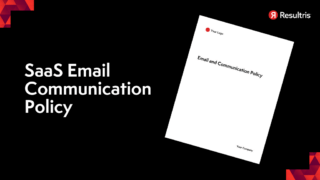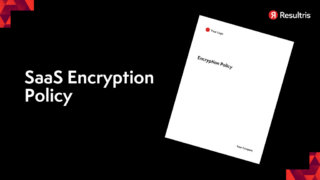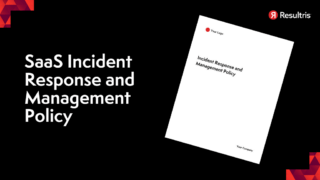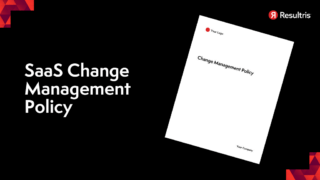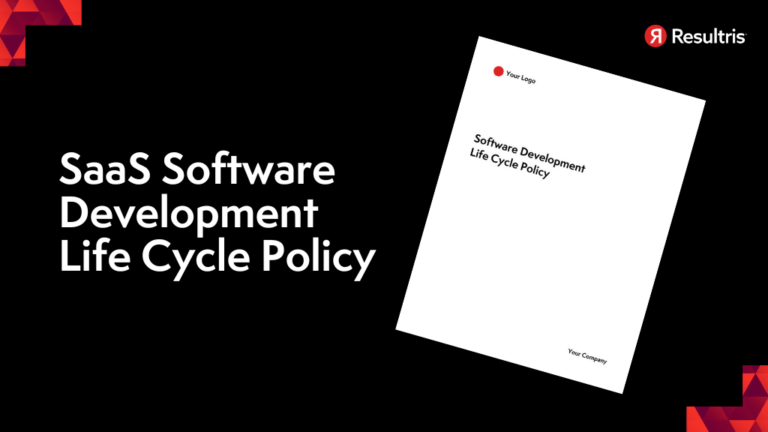
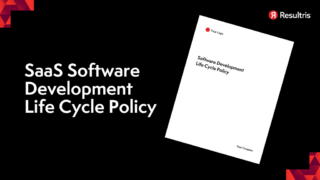
Written by: Tim Eisenhauer
Last updated:

In the fast-paced world of software-as-a-service (SaaS), it’s not just about developing cutting-edge applications. It’s also about ensuring that your software development life cycle (SDLC) policy is robust and compliant. This is where the concept of SaaS Compliance and Security Best Practices comes into play.
Navigating the intricacies of SaaS SDLC policy can feel like a daunting task. But don’t worry, we’ve got your back. We’ll guide you through the complexities, shedding light on the crucial aspects of compliance, security, and best practices.
Stay tuned as we delve deeper into this critical topic, providing you with the knowledge you need to confidently steer your SaaS business towards success. This is your journey into understanding and implementing an effective SaaS Software Development Life Cycle Policy.
Gaining insight into the world of SaaS software development life cycle policies starts by deciphering its complexities. Let’s explore it further.
Often referred to as the SaaS SDLC policy, this refers to a systematic series of steps or processes implemented during the creation and maintenance of software applications in a SaaS environment—cloud-based hosted applications. Its purpose? Streamlining the development process, eliminating errors, and ensuring quality control.
Contrasted with traditional SDLCs, SaaS SDLCs differ with emphasis on continuous updates, scalability, and multi-tenancy—they cater to numerous clients from the same instance of an application. Further, updates on SaaS applications occur centrally rather than on individual user devices, offering seamless integration and less hassle compared to traditional methods.
The biggest asset for SaaS companies? It’s undoubtedly their software applications. An SDLC policy guarantees these assets maintain their quality and reliability, reducing system failures and potential customer dissatisfaction.
In the fast-paced SaaS industry, companies work tirelessly to keep their competitive edge. An effective SDLC policy helps keep your software up-to-date, innovative, and ahead of competitors—it’s the booster shot for your business resilience.
Regulations like GDPR and HIPAA can’t be taken lightly. Especially in SaaS, where client data handling often takes center stage. Following an SDLC policy helps ensure that your applications comply with these regulations, protecting you from bans, and boosting trust among your users—indeed, a win-win situation.
Understanding the core components of a SaaS SDLC policy helps in maintaining the competitive advantages of your organization and in ensuring that your product complies with regulations such as GDPR and HIPAA. Covering every phase of the SDLC, from planning to maintenance, this policy strategically integrates methodologies like Agile and DevOps while considering security and compliance aspects.
First things first, it’s about understanding your needs and troubles, your market position, and your customer base in the planning phase. This step involves defining clear goals, identifying potential stakeholders, and articulating practical product requirements.
Once you understand what you’re building, you transition into the design stage. In this phase, architects and designers create a blueprint for your SaaS product, followed by the prototyping stage where an initial design model of the product is created for testing purposes.
With a working model in hand, the core development phase begins. This stage involves extensive coding, where your SaaS product starts taking its actual form and becomes a tangible application.
Next, it’s time to guarantee that the newly created SaaS application performs as it’s supposed to. Rigorous testing and quality assurance measures are carried out to identify bugs, glitches, and overall performance issues, ensuring that the final product is up to the mark.
After a meticulous phase of testing and QA, it’s launch time. The deployment phase involves transferring the SaaS application to a live environment, quickly followed by the product’s formal release to the end-users and the public.
Finally, the maintenance phase ensures that you stay current. Regular updates, bug fixes, feature enhancements, and proactive handling of any issues that arise after deployment ensure the longevity and reliability of your SaaS product.
A key component of a great SaaS SDLC policy is the integration of Agile and DevOps practices into the entire cycle. Agile encourages incremental, iterative work cadences, while DevOps bridges the gap between development and operations teams. These integrations lead to greater efficiency and continuous delivery of high-quality software.
Last but certainly not least, your SaaS SDLC must incorporate robust security measures and ensure strict adherence to compliance norms. Whether it’s GDPR, HIPAA, or other regional and subject-specific regulations, your policy must prioritize the protection of user data while maintaining application integrity and reliability. A privacy-first approach coupled with robust security mechanisms translates into increased consumer trust and a competitive edge for your organization.
The SaaS SDLC policy isn’t a solitary endeavor. It involves numerous stakeholders, each with vital roles and responsibilities ensuring efficient policy implementation.
Executives play a crucial part. They dictate strategic direction, oversee policy enforcement, and guarantee compliance adherence. For a SaaS SDLC policy, higher-level decision-making rests with them. They set the parameters, aligning the policy objectives with the broader business goals. While steering the technology roadmap, they ensure necessary resources, including manpower and budget allocation, remain readily available.
Development teams bear an equally significant burden. They’re in the coding trenches, architecting the software to meet the outlined objectives. These professionals work in sprints, building and refining various system functionalities. Their responsibilities span the entire cycle, from ideation to coding and debugging. Moreover, they must perform robust unit tests, confirm software compliance, and document each development phase meticulously. They need to possess an inherent aptitude for problem-solving, ensuring the software delivery aligns with the company’s strategic direction.
With the development process underway, the Quality Assurance (QA) and testing teams arrive. They ensure the system’s integrity, validating that it’s free from errors and glitches. They conduct thorough testing – functionality, regression, performance, and security. Finding and fixing bugs remains their prime responsibility, eliminating any chance for operational inconsistency or data breach. They’re particularly keen on adhering to compliance norms, ensuring the software meets GDPR and HIPAA standards.
The operations and DevOps team act as the bridge, fostering symbiosis between development and operational functionalities. Following Agile and DevOps methodologies, they guarantee a smooth transition of the software from development to deployment. Their key role extends to infrastructural management, continuous integration, and consistent release practices. They also handle any operational hiccups, ensuring business continuity and minimizing system downtime.
Finally, the customer success team provides a rounded edge to the SaaS SDLC Policy. They’re the customer voices within the organization, translating feedback into actionable insights. They refine product utility, improve performance, and elevate customer satisfaction. By liaising with other teams, they expedite the feedback loop into the SDLC, fostering continuous improvements. Their pivotal role is to identify client needs, address pain points, and optimize user experience, driving product success and organizational growth.
Embarking on the formulation of your SaaS SDLC policy comes with its unique challenges. But, armed with knowledge about your organization’s needs, you’re ready to take the next big step.
Before redefining the wheel, it’s important to take a keen look at your existing practices. This involves identifying the strengths and weaknesses of your current SDLC strategy. Ask yourself: What methods are effective? What phase needs revamping? Dive into your historical data. It provides a clear picture of your past performance and offers a foundation upon which your new SDLC policy is built.
Specific, measurable goals and objectives provide a roadmap for your SaaS SDLC policy. What are you targeting in terms of release frequency, customer feedback integration, or software quality? Pinpoint these targets and articulate them clearly. Having crisp, numerical objectives directs your strategies towards well-defined outcomes.
Simplified processes and workflows eliminate roadblocks and foster seamless software development. You might consider harnessing Agile and DevOps methodologies, basing them on the goals defined earlier. Agile focuses on continuous incremental improvements while DevOps encourages faster, frequent deployments. Together, they’re instrumental in the development, testing, and deployment of your software.
Leverage technology as your ally. Your toolbox might include API management solutions, continuous integration and delivery tools (CI/CD), automated testing tools, and container orchestration systems. The aim is to bring about a more efficient, streamlined, and automated SaaS SDLC.
A policy is only as good as its implementation. Train your teams on the why and the how of your new policy. Regular workshops, online training modules, and interactive discussions foster smooth transition and adoption. Finally, don’t forget to involve key stakeholders at every stage. Garnering their feedback and suggestions promotes buy-in and ensures your SaaS SDLC policy is robust, flexible, and primed for success.
Based on the complexities involved in SaaS SDLC policy, adopting best practices ensures efficient software delivery and regulatory compliance. Let’s delve into some of these best practices:
Continuous Integration and Continuous Deployment represent critical practices in the SaaS SDLC. They enable consistent code integration, timely issue detection, and automated software release, boosting product quality, and speeding up time-to-market. Employing CI/CD, you can catch bugs earlier in the development cycle, leading less remedial work in later stages.
Quality assurance won’t happen by accident in the realm of SaaS software. With automated testing, you can help ensure the consistency and reliability of your software output, especially when coupled with a robust CI/CD pipeline. Automated testing, whether it’s unit, functional, integration, or performance testing, leads to quick error detection, thereby enhancing product quality.
Code is the lifeblood of any software, and managing it effectively is instrumental in successful software delivery. Using version control systems such as Git, you can track changes, create different versions of your software, and collaborate better with your development team, avoiding those sleepless nights of merging code manually or losing changes.
Lastly, never underestimate the power of good documentation and knowledge sharing in the software development life cycle. Documentation provides a roadmap to developers, testers, and stakeholders about how the software works and the decisions behind it. When you share knowledge among team members, you foster a learning environment, enabling developers to write better code, handle bugs more efficiently, and future-proof your SaaS applications.
If you’re keen on enhancing your SaaS SDLC, it’s imperative to measure its effectiveness. It boils down to examining performance data, exploring user feedback, and initiating constant improvements. Below, we’ll tackle the details to make your SDLC process more effective.
KPIs comprise pivotal measures, enabling you to gauge software development progress accurately. You’d track details like code quality, defect density, or lead time, relying on hard data to extract insights. For instance, maintaining a low number of bugs per thousand lines of code can indicate code health, guiding decision-making.
Setting up feedback loops and conducting frequent retrospectives helps you identify problematic areas timely. Let’s say you review user comments and discover concerns over software speed, that’s a clear sign to improve your code optimization. Additionally, engaging in steady improvement cycles ensures you’re on top of your software game, always. These cycles consider feedback, instigate necessary alterations, foster closer collaboration, and encourage persistence in refinement.
Despite the outlined best practices, SaaS SDLC can be a challenging journey. Here’s a quest that isn’t short of hurdles. However, the rewards are ample for those who address these challenges head on.
In an expanding SaaS market, speed in delivery proves critical. However, releasing features quickly can compromise software quality, resulting in potential mishaps. So how do you strike a balance? The best solution lies in automated testing and continuous integration methods. These systems allow for faster feedback loops during the development cycle, detecting issues early and reducing the releasing time. Pairing these workflows with Agile methodology allows constant evaluation and refinement, ensuring quality doesn’t become a casualty of speed.
Technical debt refers to the imminent work resulting from prioritizing quick solutions over optimal ones. It’s a cumulative load that can severely impede the development cycle over time. Nipping this challenge in the bud requires a conscious effort in maintaining clean codebase and utilizing a sound version control process. Regularly scheduled code reviews and whole-team ownership of the code can transform this looming obstacle into an effective springboard for growth. Furthermore, leveraging automated tools for code consistency keeps technical debt in check.
As SaaS companies thrive, they face the challenge of ramping up their development processes to meet increased demands. Developers could be trapped in a whirl of proposed updates, risking a fall in productivity. To scale effectively, strong consideration needs to be given to continuous deployment methods. This initiative nurtures a consistent development workflow, keeps product iterations on track, and paves the path for sustained scalability. Another critical method is modular programming. This allows for efficient code management, reduces complexity, and enhances the scalability potential of the software solution. Implementing DevOps culture promotes collaboration and aligns operational objectives, creating a conducive environment for the progressive scaling of development processes.
Remember, the goal isn’t to totally vanquish these challenges, but rather to manage them effectively. It’s a dynamic world and challenges will always appear in new faces. However, an efficient SaaS SDLC policy fortifies your software development strategy against these hurdles, thus fostering overall business growth.
Redefining your software development practices per different SaaS models can be a game-changer. It allows for enhanced customer satisfaction and maximized ROI. Let’s delve into two notable considerations: B2B vs. B2C and enterprise vs. SMB product development.
In a B2B model, focus on strong integration capabilities, enabling seamless data transfer across a myriad of third-party services. Remember, businesses often have pre-existing systems, so interoperability becomes crucial. Aim for flexible customization to tailor services to a company’s unique processes and workflows.
Contrarily, a B2C approach dictates emphasis on exceptional user experience. Consumers yearn ease, simplicity, and immediate gratification. Focus on developing intuitive user interfaces and delivering stellar customer service. Factor in high scalability due to potentially large and fluctuating user bases.
For enterprise-level product development, robustness and scalability take center stage. The software you develop must handle hundreds, if not thousands, of users concurrently. Ensure your configuration is favorable to vast distributed teams. Concentrate on advanced data security and compliance mechanisms, as enterprises face rigid regulatory landscapes.
Conversely, SMB development requires cost-effectiveness, simplicity, and fast deployment. The teams are usually compact, hence, user-friendliness becomes cardinal. Implement easy-to-use features without compromising on quality. Also, consider affordable pricing models, as budget constraints are a common feature among SMBs.
Remember, each model possesses its unique challenges and opportunities. Your key to success lies in adjusting your SDLC phases to cater effectively to model-specific user needs. Deploying an adaptable and efficient development life cycle maintains your competitive edge in the dynamic SaaS industry.
Looking ahead, advances in technologies will mold the SaaS Software Development Life Cycle (SDLC) policy. As the vanguard in tech revolutions, trends such as AI and Machine Learning, Low-code and No-code platforms, and Edge computing and distributed systems bring about radical changes in the way SDLC operates in the SaaS eco-system.
Artificial Intelligence (AI) and Machine Learning (ML) offer novel opportunities to improve the SaaS SDLC scheme. With AI and ML, developers can automate repetitive tasks, curating a more efficient workflow. Debugging becomes simpler, as ML algorithms can identify bugs faster and more accurately compared to manual methods. This advancement reduces the time spent on bug-fixing, enabling teams to emphasize product improvement instead. Software testing, a critical factor in SDLC, could be transformed as well, leading to enhanced prediction modeling which aids in detecting user behaviour and potential security threats.
Low-code and No-code platforms, as upcoming trends, offer a paradigm shift to the conventional SaaS SDLC. They allow users with no previous programming experience to design and deploy apps at a much faster pace. These platforms expedite the coding phase in the SDLC, reducing the time-to-market for businesses. Moreover, with less reliance on technical manpower, resources can be optimized well. Collaboration across non-technical and technical teams with these platforms adds to the streamlining of processes, contributing to efficient software development.
With SaaS becoming more data-centric and requiring real-time responsiveness, Edge computing and distributed systems prove instrumental in revolutionizing the SDLC policy. Edge computing enables data to be processed closer to where it’s generated, reducing latency issues, which improves customer experience. On the other hand, distributed systems bring robustness to the SaaS architecture, ensuring high availability and scalability. Both these aspects crucially enhance the maintenance and performance testing phases of SDLC, pivotal elements to keep your SaaS offering competitive in the fast-paced technology landscape.
Embracing these developing technologies could mean a game-changing shift for SaaS SDLC. Be ready to adapt and ride the wave of these trends, ensuring ahead-of-the-curve software development practices.
You’ve seen how crucial a robust SDLC policy is in the SaaS industry. It’s not just about meeting client needs but ensuring product quality, competitiveness, and compliance with regulations. By integrating Agile and DevOps methodologies, you can navigate complexities like continuous updates and scalability. Adapting your SDLC for different SaaS models can further strengthen your approach.
Future trends, such as AI and Machine Learning, Low-code and No-code platforms, and Edge computing, are reshaping SDLC practices. These advancements aren’t just buzzwords—they’re real opportunities for automation, faster development cycles, improved testing, and enhanced customer experience. They’re the future of software development in the SaaS industry. So, as you implement and evolve your SDLC policy, remember to keep an eye on these trends. They could be the key to your next breakthrough.
Disclaimer
Please note that the information provided in this blog post is for informational purposes only and does not constitute legal advice. We are not lawyers, and reading this content does not create an attorney-client relationship. For legal advice specific to your situation, please consult with a qualified attorney.

